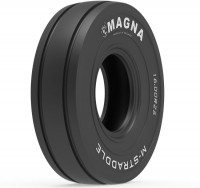Titan outlines the ABCs of agri tyre maintenance
The performance of equipment in the field can greatly impact productivity, and thus, bottom line. Titan International points out that tyres are a very important part of this equation, and with regular inspection, and – if necessary – minor adjustments, agricultural machinery operators can see great improvements in the durability and performance of the tyres in the field. Titan says that following the completion of spring planting, the time is right to inspect tyres and make necessary adjustments to ensure the rest of the season goes off without a hitch.
Scott Sloan, agricultural product manager for Titan and Goodyear Farm Tires, says it’s as simple as following the ABCs.
Analyse tyre performance
The first step to making sure your tyres are adjusted correctly is to conduct regular inspections. Signs of premature wear can often help pinpoint a problem that can be easily remedied.
“Signs of uneven wear are often related to incorrect inflation pressures,” explains Sloan. “An overinflated tyre tends to ride on the center of the tyre, to the point the shoulders of the tyre are barely touching the ground. This can wear out the tread in the middle of the tyre and aggravate compaction issues, whereas an underinflated tyre creates more deflection on the sidewall, which can make the sidewall more susceptible to flex cracking and puncture damage.”
Another common problem faced by growers is stubble damage.
“Signs of pecking and chipping to tractor and implement tyres often indicate that stubble is posing a problem,” says Sloan. “However, this can be remedied by making some minor adjustments to the way you operate the equipment and/or by outfitting your tractor with one of the many available aftermarket products that help combat stubble.”
In addition to inspecting for damage to the tyres, it’s important to take a look at overall performance of the tyres in the field during the spring planting season. Key areas of performance linked to tyres include traction and ride quality.
“Having adequate traction can improve fuel efficiency and productivity while ride quality keeps the operator comfortable and productive throughout the season,” says Sloan. “Without the proper inflation pressures and weight distribution, growers can experience road lope, power hop and tyre slippage in the field — all of which can be remedied through a few minor adjustments.”
Ballast, inflate and operate
Once you’ve pinpointed the issues, it’s time to make adjustments. To improve traction, Sloan recommends first looking at ballast and weight distribution.
“One of the major causes of power hop is insufficient overall tractor weight for the horsepower. As a general rule, follow the recommendations of the tractor manufacturer for weight-to-horsepower ratio,” says Sloan. “Weight distribution is also very important to both ride quality and traction. It’s best to consult with the tractor manufacturer to determine the optimum weights for the type of implement you’re running, and add cast ballast to achieve the proper distribution and ratios.”
Inflation pressure also plays a key role — not only in ride quality and performance, but in tyre longevity.
“Maintaining proper inflation pressures based on load is the best way to make sure your tyres last longer and give you the best performance in the field,” says Sloan. “Once you’ve weighted your tractor for optimum ride quality and traction, it’s very easy to adjust inflation pressures based on the load/inflation tables provided by the Tire and Rim Association.”
Lastly, Sloan recommends making some minor adjustments to the way you operate your equipment in order avoid stubble.
“Limiting stubble damage can be as simple as setting your tractor tyres to run between the rows rather than over them,” says Sloan. “In cases when that’s not possible — for instance if you’re running wide tyres, such as 900s, in narrow row crops — it may be worth exploring the use of aftermarket attachments such as Stalk Stompers.”
Call your local dealer
Sloan stresses that in any case, leveraging the expertise of your local tyre dealer can make all the difference in the world.
“A lot of times, performance simply comes down to having the right tyre for the job,” says Sloan. “New tyre technologies are introduced all the time to help combat the challenges faced by today’s growers. So, in many cases, there may be a new tyre available that can help you address specific field challenges, and your dealer can assist in selecting exactly what is needed to rectify any issues you may be having.”





Comments